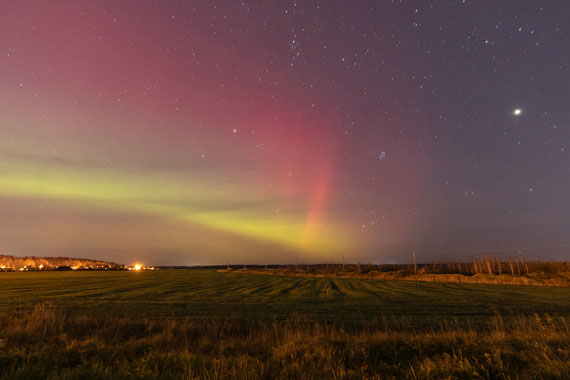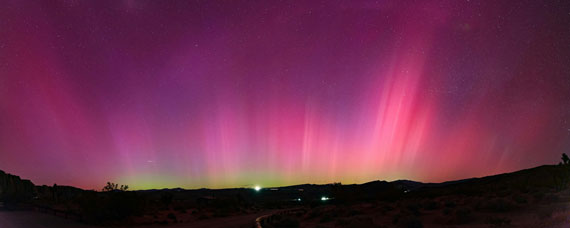Geomagnetic storms, often referred to as space weather, are caused by disturbances in Earth’s magnetosphere due to solar wind. While they can disrupt communications and navigation systems, they also offer a rare and spectacular opportunity for photographers. The most famous visual manifestation of geomagnetic storms is the aurora borealis, or northern lights, in the Northern Hemisphere, and the aurora australis in the Southern Hemisphere. Here’s how you can make the most of your photography during these celestial events.

Photo captured by Alexander Fastovets; 11mm, f/2.8, 30s, ISO 1000
Understanding Geomagnetic Storms and Auroras
Auroras occur when charged particles from the sun collide with atoms in Earth’s atmosphere. These collisions cause the atoms to light up, creating stunning displays of colors that dance across the sky. The intensity and visibility of auroras are influenced by the strength of the geomagnetic storm, which is measured by the Kp index. A higher Kp index means more intense auroras that can be seen further from the poles.
Planning Your Shoot
- Timing: Geomagnetic storms can be predicted, so keep an eye on space weather forecasts. Websites and apps like SpaceWeatherLive and Aurora Alerts can provide real-time updates on solar activity and aurora visibility.
- Location: The best locations are away from city lights, which means heading to rural areas or national parks. Northern countries like Canada, Norway, Sweden, and Finland are prime spots for northern lights. For the southern lights, consider Tasmania or New Zealand’s South Island.
- Weather Conditions: Clear, dark skies are essential. Check the weather forecast to ensure there are no clouds or precipitation expected during your shoot.
Equipment Essentials
- Camera: A DSLR or mirrorless camera with manual settings is ideal. These cameras allow for better control over exposure, ISO, and focus.
- Lens: A wide-angle lens (14-24mm) with a large aperture (f/2.8 or lower) will capture more of the sky and let in more light.
- Tripod: A sturdy tripod is crucial for long-exposure shots to prevent camera shake and ensure sharp images.
- Remote Shutter Release: This helps to minimize camera shake when taking long exposures.
Camera Settings
- ISO: Start with an ISO of 800 to 3200. Higher ISOs will make your sensor more sensitive to light, but be mindful of noise.
- Aperture: Use the widest aperture your lens allows (e.g., f/2.8). This will let in the most light and create beautiful, star-filled backgrounds.
- Shutter Speed: Start with a shutter speed between 5 and 30 seconds. Longer exposures will capture more light but may blur the aurora’s movement.
- Focus: Manually set your focus to infinity. Use live view and magnify a bright star or distant light to ensure precise focus.

Photo captured by Sheng Hu
Composition Tips
- Foreground Interest: Incorporate interesting foreground elements like trees, mountains, or water bodies to add depth and context to your photos.
- Rule of Thirds: Position the horizon along the lower third of the frame to give prominence to the auroras.
- Experiment: Try different angles and compositions. Sometimes the most unexpected shots turn out to be the best.
Post-Processing
- Noise Reduction: Use software like Adobe Lightroom to reduce noise, especially if you used a high ISO.
- Color Correction: Adjust the white balance to bring out the true colors of the aurora. You may need to tweak the greens, purples, and reds.
- Sharpening: Enhance the clarity and sharpness to highlight the details of the aurora.
Safety and Comfort
- Warm Clothing: Dress in layers and bring extra warm clothing. Geomagnetic storms are more likely to be seen in cold regions.
- Stay Informed: Keep an eye on space weather updates and local conditions to make the most of your photography session.
- Backup Plan: Always have a plan B in case weather conditions change suddenly.
Photographing geomagnetic storms and the resulting auroras can be a once-in-a-lifetime experience. With careful planning, the right equipment, and a bit of luck, you can capture stunning images of these natural phenomena. Remember to enjoy the moment as well—sometimes, the best memories are made without a camera. Happy shooting!
For Further Training:
For help remembering the camera settings for difficult situations like Auroras, a set of Photography Adventure Cheat Sheets are designed to help. They are currently 80% off today if you want to check them out.
The perfect companion for any photographer. Print one out whenever you need it. Whether you’re going on vacation or seeking out a specific photography adventure, these cheat sheets can provide you with the knowledge and inspiration you need to create your best work yet.
Deal ending soon: The Photography Adventure Cheat Sheets at 80% Off
- - - - - - - - - - - - - - - - - - - - - - - - - - - - - - - - - - - - - - - - - - - - - - - - - - - - - - - - - - - - - - - - - - - - - - - - - -
Photography, like any art or skill, thrives on consistency. The journey to becoming an adept photographer is paved with regular practice. Learn how PictureCorrect Insiders can help.
- - - - - - - - - - - - - - - - - - - - - - - - - - - - - - - - - - - - - - - - - - - - - - - - - - - - - - - - - - - - - - - - - - - - - - - - - -
This post Chasing Auroras: Photography in Geomagnetic Storms appeared on PictureCorrect.
from PictureCorrect https://ift.tt/TY7JPcz
via IFTTT







0 kommenttia:
Lähetä kommentti